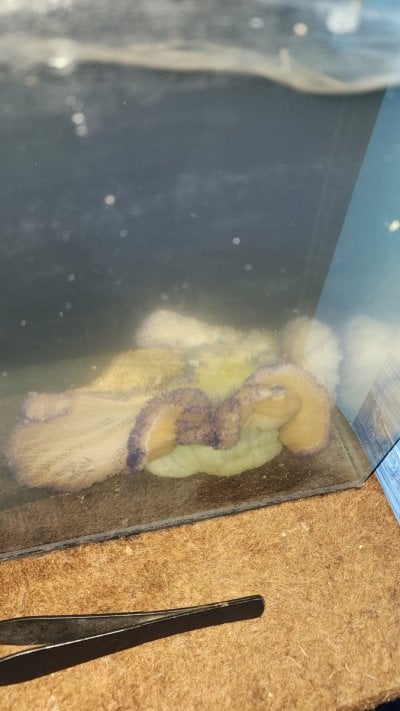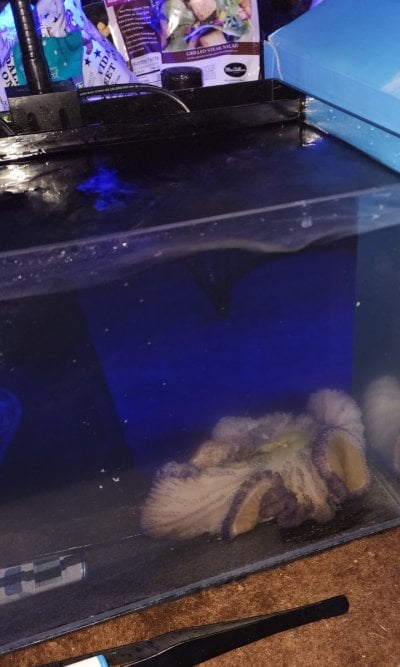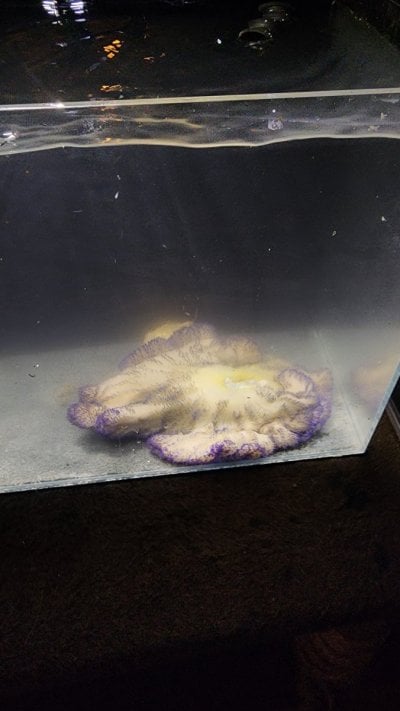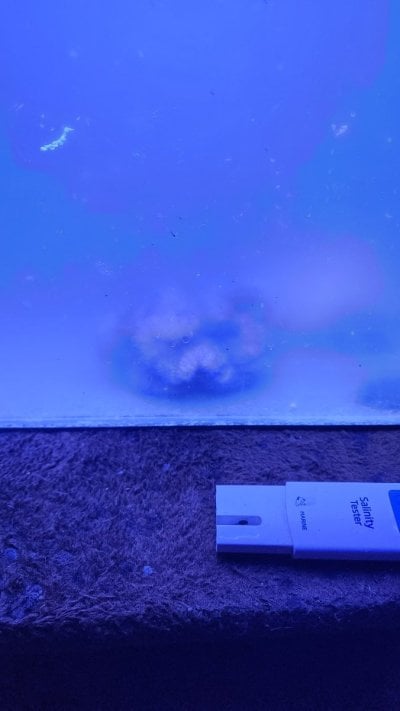Unfortunately, dead gigs can still be sticky. The nematocysts can still fire after the rest of the anemone has started to decompose (they typically die from the inside out, and the antibiotics we use have a way of "pickling" them).
Navigation
Install the app
How to install the app on iOS
Follow along with the video below to see how to install our site as a web app on your home screen.
Note: This feature may not be available in some browsers.
More options
You are using an out of date browser. It may not display this or other websites correctly.
You should upgrade or use an alternative browser.
You should upgrade or use an alternative browser.
New S. Gigantea, another Cipro adventure
- Thread starter slickcg33
- Start date
- Tagged users None
Well it's definitely dieing from the inside.. crazy amount of guts being spewed out and cloudy expell, (nothing since after wc though) we'll see if it can stop that process.Unfortunately, dead gigs can still be sticky. The nematocysts can still fire after the rest of the anemone has started to decompose (they typically die from the inside out, and the antibiotics we use have a way of "pickling" them).
Potential positives:
Foots reactive and holding (it pulled off glas earlier when it stuck to my hand and is now back holding on the glass)
Mouth is still changing shape throughout the day. And is a bit more closed this evening.
Alright boys and girls, I think we're nearing the end of this journey.
I woke up this morning with another nuked tank.
I usually wait till the end of the day for water change, but had to do it before leaving for work.
I don't want to throw in the towel, but I'm unable to monitor it today, have 12-16 hours of work.
If tank is nuked again returning home that might be time to call it.
I woke up this morning with another nuked tank.
I usually wait till the end of the day for water change, but had to do it before leaving for work.
I don't want to throw in the towel, but I'm unable to monitor it today, have 12-16 hours of work.
If tank is nuked again returning home that might be time to call it.
Attachments
If you have a turkey baster and can shoot water into its mouth, if it's floppy (the pressure causes it to ripple) IME it means it's dead (or at least to the point where it won't recover). Surprisingly, they still have the ability to say put even when they're dead. I assume it's like a suction cup where once it's in place, it doesn't move unless pried off where water can get underneath to lose suction.
Had this been earlier in the QT process, I would've said that the cloudiness could be from a stress spawn, but in this can I think it's just he inside of the nem starting to decompose.
Had this been earlier in the QT process, I would've said that the cloudiness could be from a stress spawn, but in this can I think it's just he inside of the nem starting to decompose.
This is what it's expelling. Doesn't smell decomposed but I think it's it's own stomach. Slightly blue tint just like anemone colorIf you have a turkey baster and can shoot water into its mouth, if it's floppy (the pressure causes it to ripple) IME it means it's dead (or at least to the point where it won't recover). Surprisingly, they still have the ability to say put even when they're dead. I assume it's like a suction cup where once it's in place, it doesn't move unless pried off where water can get underneath to lose suction.
Had this been earlier in the QT process, I would've said that the cloudiness could be from a stress spawn, but in this can I think it's just he inside of the nem starting to decompose.
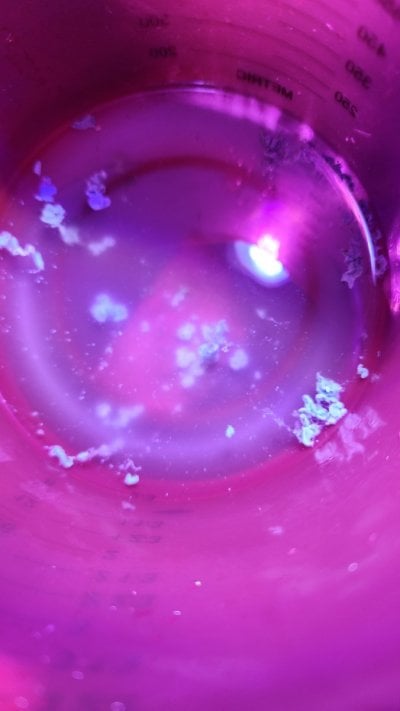
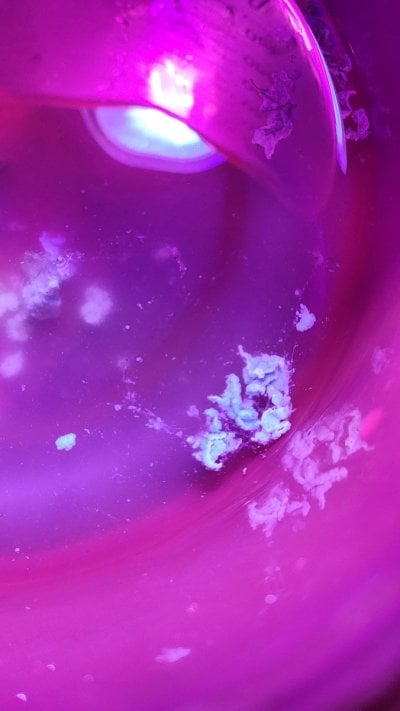
This morning looking much worse.... Another nuked tank, remaining internals are exposed / expelled.
Its still alive, changing shape on its own power (observed when pumps were off after water change). However I expect it to be completely gone when I get home from work tonight.
That leaves me with some thoughts as I reflect over the past few days.
First off, the hardest thing for me to tackle is the idea that if the anemone was still in the DT and I hadn't done the QT process that it would still be alive. Now I'm not saying it would be healthily, or that it wouldn't eventually die, just that it would be in significantly better shape then it is now.
When I pulled the anemone from the DT originally it was inflating and deflating each day and had an open mouth about half the time, specifically when deflated.
Another consideration... I've completed cipro treatments in the past on multiple gigs successfully. In recent years I've only been successful with the treatment on a H.Mag, no Gigs. I'm now 0/4 on Gigs within the last two years.
With the above information i find myself considering the following;
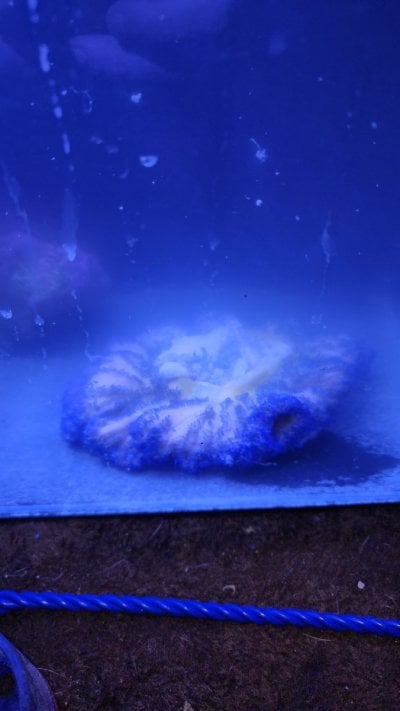
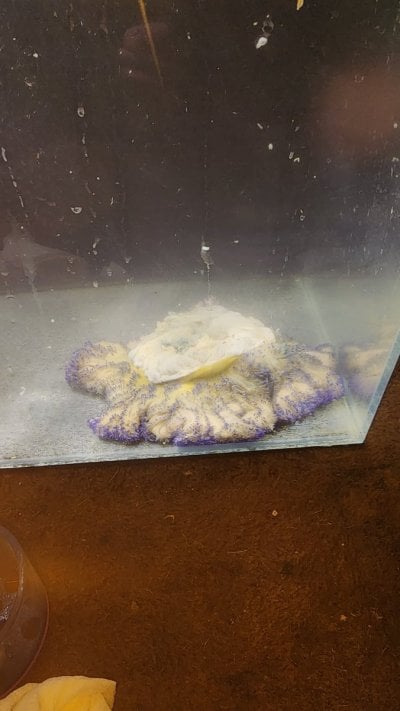
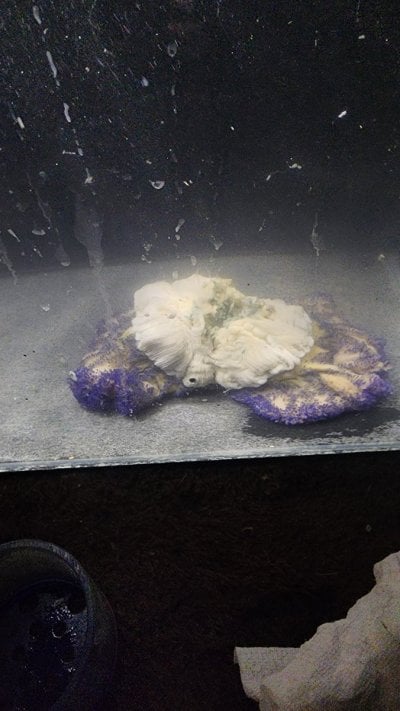
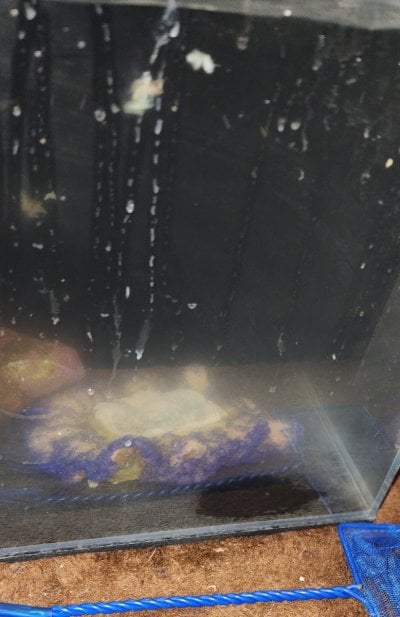
Its still alive, changing shape on its own power (observed when pumps were off after water change). However I expect it to be completely gone when I get home from work tonight.
That leaves me with some thoughts as I reflect over the past few days.
First off, the hardest thing for me to tackle is the idea that if the anemone was still in the DT and I hadn't done the QT process that it would still be alive. Now I'm not saying it would be healthily, or that it wouldn't eventually die, just that it would be in significantly better shape then it is now.
When I pulled the anemone from the DT originally it was inflating and deflating each day and had an open mouth about half the time, specifically when deflated.
Another consideration... I've completed cipro treatments in the past on multiple gigs successfully. In recent years I've only been successful with the treatment on a H.Mag, no Gigs. I'm now 0/4 on Gigs within the last two years.
With the above information i find myself considering the following;
- If I had just left the anemone alone, do they ever beat the infections naturally and rebound, or was this an inevitability?
- If i had pulled the anemone sooner would the Cipro process have been more affective? (Felt like I pulled it relatively early)
- For larger anemones, would doubling the dosage and completing this in a 20Gal (water volume not tank size) be a better process (more water, less water volatility when anemone expels waste)?
- Has Cipro become so widely adopted over the years that the anemones we get now have either;
- A natural resistance from residual Cipro in retail/wholesale holding tanks
- Already been through a round of Cipro and are resistant to the 250mg dosage
- or conversely, have already been through a round of Cipro and are now hyper sensitive to it
- Have you guys recently been successful with this process (lets say last two years), or have you found your successes aren't as bountiful as they once were?
- If a large majority are finding their success numbers have also diminished over the years, is it time to reevaluate the dosage or antibiotic type? (or is this just me failing 4 attempts in a row having a subjective tilted view?)




Last edited:
I think you start the process too late, rather than too early.
Deflate and inflate is the process where the anemone purge infection/irritant inside of it. In the wild, the water pumped out by the anemone will get carry away by the current and the anemone inflated in clean fresh disease-free water. It can do this several time and may be able to fight off infection. In the aquarium, the wasted infected water stays around and re-inflated the anemone and seeded the anemone with infected water, so this process does not help the anemone too much.
I don't treat all the anemone on arrival, but I do have antibiotic and QT tanks and equipment's available. If the anemone deflates after been in QT (all go into QT, no exception) after 24 hrs, I will START treatment. All deflated anemone in QT gets 100% water change BEFORE they inflated again. This mimics what would happen in nature. I cannot stress how important this is. I do a lot of water changes with treatment, several hundred gallons of water for each anemone I treated. I always pump new water to my DT and use DT water for my treatment tank. This way I don't have to worry about temperature and salinity instability and newly mixed water issues, and not wasting the water I used for treatment.
My QT/HT got the same high water quality, light and current like in DT. I can keep anemone essentially indefinably in my QT if I choose and would know that they get great quality of care, and won't suffer from been in QT.
Better luck next time. Treat earlier and pays more attention to water changes with treatment.
Deflate and inflate is the process where the anemone purge infection/irritant inside of it. In the wild, the water pumped out by the anemone will get carry away by the current and the anemone inflated in clean fresh disease-free water. It can do this several time and may be able to fight off infection. In the aquarium, the wasted infected water stays around and re-inflated the anemone and seeded the anemone with infected water, so this process does not help the anemone too much.
I don't treat all the anemone on arrival, but I do have antibiotic and QT tanks and equipment's available. If the anemone deflates after been in QT (all go into QT, no exception) after 24 hrs, I will START treatment. All deflated anemone in QT gets 100% water change BEFORE they inflated again. This mimics what would happen in nature. I cannot stress how important this is. I do a lot of water changes with treatment, several hundred gallons of water for each anemone I treated. I always pump new water to my DT and use DT water for my treatment tank. This way I don't have to worry about temperature and salinity instability and newly mixed water issues, and not wasting the water I used for treatment.
My QT/HT got the same high water quality, light and current like in DT. I can keep anemone essentially indefinably in my QT if I choose and would know that they get great quality of care, and won't suffer from been in QT.
Better luck next time. Treat earlier and pays more attention to water changes with treatment.
- Joined
- Mar 5, 2018
- Messages
- 1,108
- Reaction score
- 873
I wonder the same ..I know a fellow hobbyist that does NOT treat nems..He puts them in a holding tank with an algae scrubber that utilizes a dump bucket..The nems get strong water surges every time the dump bucket drops , and he does many large water changes over the 1st few days of treatment.. W/C's helps them purge ? Clean oxygenated water from the scrubber helps them clear up infection ? All things I wonder about ...If I had just left the anemone alone, do they ever beat the infections naturally and rebound, or was this an inevitability?
I think this could definitely help, as it does help to remove the pathogen but allows the anemone to completely purge its system periodically. It's basically the same process as Cipro QT, but without the Cipro. I firmly believe that the pathogen is directly tied to the zooxanthellae, since all infected anemones expel dead zoox. They have to be able to expel the pathogen without taking any back in, so clean water is essential. This is also why they do the deflate/inflate process over and over. We NEVER see this with healthy gigantea.I wonder the same ..I know a fellow hobbyist that does NOT treat nems..He puts them in a holding tank with an algae scrubber that utilizes a dump bucket..The nems get strong water surges every time the dump bucket drops , and he does many large water changes over the 1st few days of treatment.. W/C's helps them purge ? Clean oxygenated water from the scrubber helps them clear up infection ? All things I wonder about ...
I think you start the process too late, rather than too early.
Deflate and inflate is the process where the anemone purge infection/irritant inside of it. In the wild, the water pumped out by the anemone will get carry away by the current and the anemone inflated in clean fresh disease-free water. It can do this several time and may be able to fight off infection. In the aquarium, the wasted infected water stays around and re-inflated the anemone and seeded the anemone with infected water, so this process does not help the anemone too much.
I don't treat all the anemone on arrival, but I do have antibiotic and QT tanks and equipment's available. If the anemone deflates after been in QT (all go into QT, no exception) after 24 hrs, I will START treatment. All deflated anemone in QT gets 100% water change BEFORE they inflated again. This mimics what would happen in nature. I cannot stress how important this is. I do a lot of water changes with treatment, several hundred gallons of water for each anemone I treated. I always pump new water to my DT and use DT water for my treatment tank. This way I don't have to worry about temperature and salinity instability and newly mixed water issues, and not wasting the water I used for treatment.
My QT/HT got the same high water quality, light and current like in DT. I can keep anemone essentially indefinably in my QT if I choose and would know that they get great quality of care, and won't suffer from been in QT.
Better luck next time. Treat earlier and pays more attention to water changes with treatment.
I completely agree with all of this.
Specifically regarding gigantea, I can't stress how important it is to NOT add it to the DT right away, no matter how good it looks. They can take up to a month to show symptoms. They also don't respond to high levels of phosphate, so it water quality isn't pristine, this could exasperate the problem. Once it deflates even ONCE, you must absolutely start treatment.
This is why I always use fresh salt water when QTing anemones -- never tank water -- since it eliminates any possibility of irritants (bacteria, chemicals already present such as lanthanum chloride, pathogens such as ich, etc.).
Regarding use of Cipro, there's no correct answer. I've been researching the supply chain for gigantea for years, trying to pinpoint collectors, exporters, and importers, and there are too many entry points and each has their own protocol. I've heard that some exporters blanket treat their anemones with Cipro but the protocal isn't thorough, so it may do more harm than good. Ideally you want the shortest supply chain possible, so that we can treat the anemones on our own. If you can find a LFS that imports direct, that's the best option.
Regarding water volume, I do think doubling for larger specimens should help. What's that saying? "Dilution is the solution to pollution"
Since the price of gigantea has increased significantly, I haven't been tempted to buy one. In the past couple of years, I've only treated a blue one for a friend. I was able to successfully treat it with Cipro, but he managed to kill it. I've had much better luck with magnifica. Some I didn't need to treat.
This sounds like Haddonis over here. The only gigs I lost are ones that are already doing poorly and I get at a discount (2 out of 10) and the mags are super healthy (0 for 4), but I lost 50% of the Haddonis (5 out of 10) I've gotten because they're from Indonesia rather than locally from Okinawa (And they don't tolerate antibiotics nearly as well as gigs/mags IME).I completely agree with all of this.
Specifically regarding gigantea, I can't stress how important it is to NOT add it to the DT right away, no matter how good it looks. They can take up to a month to show symptoms. They also don't respond to high levels of phosphate, so it water quality isn't pristine, this could exasperate the problem. Once it deflates even ONCE, you must absolutely start treatment.
This is why I always use fresh salt water when QTing anemones -- never tank water -- since it eliminates any possibility of irritants (bacteria, chemicals already present such as lanthanum chloride, pathogens such as ich, etc.).
Regarding use of Cipro, there's no correct answer. I've been researching the supply chain for gigantea for years, trying to pinpoint collectors, exporters, and importers, and there are too many entry points and each has their own protocol. I've heard that some exporters blanket treat their anemones with Cipro but the protocal isn't thorough, so it may do more harm than good. Ideally you want the shortest supply chain possible, so that we can treat the anemones on our own. If you can find a LFS that imports direct, that's the best option.
Regarding water volume, I do think doubling for larger specimens should help. What's that saying? "Dilution is the solution to pollution"
Since the price of gigantea has increased significantly, I haven't been tempted to buy one. In the past couple of years, I've only treated a blue one for a friend. I was able to successfully treat it with Cipro, but he managed to kill it. I've had much better luck with magnifica. Some I didn't need to treat.
@OrionN thanks for the tips about massive water changes, I will apply this to future haddonis especially.
Any chance you’d be willing to share your research?I've been researching the supply chain for gigantea for years, trying to pinpoint collectors, exporters, and importers, and there are too many entry points and each has their own protocol.
OP- so sorry for your loss.
- Joined
- Mar 5, 2018
- Messages
- 1,108
- Reaction score
- 873
That is the vendor with the greenhouse setup..If you can find a LFS that imports direct, that's the best option.
Hah! I'm not planning to write a research paper, if that's what you're looking for.Any chance you’d be willing to share your research?No pressure, y’all have already shared a vast wealth of info.
OP- so sorry for your loss.
I probably shouldn't have used the word "research" as that implies something a bit more formal then what I've been doing. Where should I start?
I've always been fascinated with gigantea, probably going on 20 years now. I had a tan one that I acquired from a local reefer over 10 years ago. This was prior to OrionN developing his protocol for treating anemones with antibiotics. At the time, there were only about a dozen or so people that I knew of in the US who had gigantea anemones. One person was somewhat local to me, and she had several in her collection, and we eventually became friends. We frequently messaged each other (her screen name was shutiny on Reef Central "RC") and she provided me with a ton of helpful information regarding care, reproduction, and availability of specimens via LFS and her other sources. Unfortunately, she ended up taking down her tanks and sold her entire collection of anemones, which was quite extensive. Two of her gigantea--a green and purple--are on display at the CA Academy of Sciences. I'll share a video if I can find it.
It's worth noting that prior to OrionN's protocol, gigs were being imported on a somewhat regular basis, though seasonal here in the U.S. Almost all of them died, despite everyone's best efforts to save them. By almost all, I mean ~99% failure rate. It was relatively easy to track, because at the time, RC had a lot a active members in the anemone forum, and many members posted when they acquired a gigantea, and no one knew how to save them. At the same time, I started tracking where the gigs were coming from -- from LFS or online retailer, and if I could find out if it was via exporter or wholesaler.
Once OrionN's protocol caught on, we saw a notable uptick in the survival rate. There was still a high failure rate, but the results were better than the 99% failure rate I previously described, so we were still making progress. The unknowns are still the same as they were then: we assume it's an infection, but we don't know for sure what it infects (though as I've mentioned in the past, I'm convinced the pathogen infects the zoox and not the anemone directly), what the tipping point is (where the gig recovers or it ends of dying), and what other antibiotics can be used (Cipro by far has been proven to be the most effective, though some have had success with Septra and Chemipure, which has erythromycin as its active ingredient). Results are mixed because infected gigs were treated at different times -- some were prophylactically treated and others began treatment when in terrible condition.
Over the course of ten years, I've treated around 40+ gigantea--with unfortunately--a low rate of success. At one point, I was purchasing any gig I could find, not matter the condition both via LFS and online (tan gigs were only $40 at one point and if I bought multiple specimens I'd qualify for free shipping). I slowly began to be able to assess the overall condition of a gig, and didn't purchase any I deemed not treatable. Each treatment taught me something new, which is why my protocol now includes two tanks with identical equipment--one thoroughly dries overnight while the other in use--which helps to ensure that as much of the pathogen is removed with each water change as possible. Now that my friends have gigs, and the rate of success is higher, I've stopped buying and treating them. At one point, I had 9 gigs, but have dropped my collection down to four, though I am looking for a green one to replace the one I lost a couple of years ago. I compared notes with other gig owners who have multiple specimens in the same tank, and many of us have experienced the same thing: one gig becomes dominant, while the others slowly get smaller in size and if not dealt with--either by moving to another tank or running a ton of carbon or doing frequent water changes--they slowly wither away. I simply don't have a system large enough to successfully keep multiple gigs long term.
I also found quite a few formal studies done on S. gigantea, but most were focused on neurotoxins. One that I found interesting, not due to subject matter, but rather that it mentions that people eat gigs, is this one. Unfortunately, many of the articles that I bookmarked are now behind paywalls.
There are also a lot of tidbits of information that I've gathered along the way. For example, a friend of mine who used to own a LFS and then transitioned to become an exporter told me that gigs are common, more common than haddoni, which isn't evident since we see a lot more haddoni than we do gigantea (here in the U.S.). One hobbyist was lucky enough to have his gigantea spawn, and he found what he thought were baby gigantea (and many of us concurred), but he was never able to grow them. There was a time when we saw quite a few gigantea enter the supply chain that were cut, or showed signed of being cut, but only a few survived long term. I still believe that it's not possible to force propagate them, but I know one person (who shall remain nameless because he is active on R2R) who has experimented with it.
That is the vendor with the greenhouse setup..
If it only made sense for them to QT them individually, they could be the de facto source for gigantea, though I understand the reasons why they don't.
- Joined
- Apr 23, 2019
- Messages
- 202
- Reaction score
- 84
I've seen them! They are quite beautiful, large, and healthy.Two of her gigantea--a green and purple--are on display at the CA Academy of Sciences. I'll share a video if I can find it.
+1 to some kind of allelopathy occurring among carpets in general. I run an oversized carbon reactor and ozone which seems to do the trick, but it’s visually apparent when it’s time to change the carbon in the smaller system I have that doesn’t use ozone - the anemones start to look less happy.Hah! I'm not planning to write a research paper, if that's what you're looking for.
I probably shouldn't have used the word "research" as that implies something a bit more formal then what I've been doing. Where should I start?
I've always been fascinated with gigantea, probably going on 20 years now. I had a tan one that I acquired from a local reefer over 10 years ago. This was prior to OrionN developing his protocol for treating anemones with antibiotics. At the time, there were only about a dozen or so people that I knew of in the US who had gigantea anemones. One person was somewhat local to me, and she had several in her collection, and we eventually became friends. We frequently messaged each other (her screen name was shutiny on Reef Central "RC") and she provided me with a ton of helpful information regarding care, reproduction, and availability of specimens via LFS and her other sources. Unfortunately, she ended up taking down her tanks and sold her entire collection of anemones, which was quite extensive. Two of her gigantea--a green and purple--are on display at the CA Academy of Sciences. I'll share a video if I can find it.
It's worth noting that prior to OrionN's protocol, gigs were being imported on a somewhat regular basis, though seasonal here in the U.S. Almost all of them died, despite everyone's best efforts to save them. By almost all, I mean ~99% failure rate. It was relatively easy to track, because at the time, RC had a lot a active members in the anemone forum, and many members posted when they acquired a gigantea, and no one knew how to save them. At the same time, I started tracking where the gigs were coming from -- from LFS or online retailer, and if I could find out if it was via exporter or wholesaler.
Once OrionN's protocol caught on, we saw a notable uptick in the survival rate. There was still a high failure rate, but the results were better than the 99% failure rate I previously described, so we were still making progress. The unknowns are still the same as they were then: we assume it's an infection, but we don't know for sure what it infects (though as I've mentioned in the past, I'm convinced the pathogen infects the zoox and not the anemone directly), what the tipping point is (where the gig recovers or it ends of dying), and what other antibiotics can be used (Cipro by far has been proven to be the most effective, though some have had success with Septra and Chemipure, which has erythromycin as its active ingredient). Results are mixed because infected gigs were treated at different times -- some were prophylactically treated and others began treatment when in terrible condition.
Over the course of ten years, I've treated around 40+ gigantea--with unfortunately--a low rate of success. At one point, I was purchasing any gig I could find, not matter the condition both via LFS and online (tan gigs were only $40 at one point and if I bought multiple specimens I'd qualify for free shipping). I slowly began to be able to assess the overall condition of a gig, and didn't purchase any I deemed not treatable. Each treatment taught me something new, which is why my protocol now includes two tanks with identical equipment--one thoroughly dries overnight while the other in use--which helps to ensure that as much of the pathogen is removed with each water change as possible. Now that my friends have gigs, and the rate of success is higher, I've stopped buying and treating them. At one point, I had 9 gigs, but have dropped my collection down to four, though I am looking for a green one to replace the one I lost a couple of years ago. I compared notes with other gig owners who have multiple specimens in the same tank, and many of us have experienced the same thing: one gig becomes dominant, while the others slowly get smaller in size and if not dealt with--either by moving to another tank or running a ton of carbon or doing frequent water changes--they slowly wither away. I simply don't have a system large enough to successfully keep multiple gigs long term.
I also found quite a few formal studies done on S. gigantea, but most were focused on neurotoxins. One that I found interesting, not due to subject matter, but rather that it mentions that people eat gigs, is this one. Unfortunately, many of the articles that I bookmarked are now behind paywalls.
There are also a lot of tidbits of information that I've gathered along the way. For example, a friend of mine who used to own a LFS and then transitioned to become an exporter told me that gigs are common, more common than haddoni, which isn't evident since we see a lot more haddoni than we do gigantea (here in the U.S.). One hobbyist was lucky enough to have his gigantea spawn, and he found what he thought were baby gigantea (and many of us concurred), but he was never able to grow them. There was a time when we saw quite a few gigantea enter the supply chain that were cut, or showed signed of being cut, but only a few survived long term. I still believe that it's not possible to force propagate them, but I know one person (who shall remain nameless because he is active on R2R) who has experimented with it.
I think I've seen your friend's giganteas at the Academy too!! @D-Nak thanks for sharing your story. 
PacificEastAquaculture still has a few green gigs available AFAIK, and Amazing Aquariums and Reefs has a treated neon green gig for sale but it's pricey (and i think he knows too much about gigs to want to ship it). Good luck in your search!
PacificEastAquaculture still has a few green gigs available AFAIK, and Amazing Aquariums and Reefs has a treated neon green gig for sale but it's pricey (and i think he knows too much about gigs to want to ship it). Good luck in your search!





